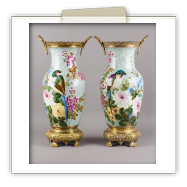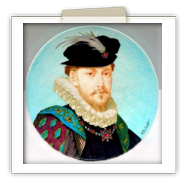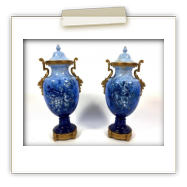Technique Barbotine
The impressionist style is directly related to the technique of so-called Slush glazed Longwy as in the factories of Montigny-sur-Loing, Bourg-la-Reine, Gien ...
This technique uses a slip, dough diluted and tinted with oxides, developed in the mid-nineteenth century by the Manufacture of Sèvres to decorate porcelain.
It is an earthy decorative coating originally raw (clay in liquid form of slip, widespread in the last quarter of the nineteenth century after being adapted to faience by Ernest Chaplet, on raw form but not dry) or cooked ( baked clay finely ground, agglomerated by a vitreous binder, more advanced form allowing to work on biscuit without risk of chipping), the slip is colored in the mass by metal compounds then it is covered by a glaze usually plumbous or alkaline-plumb ; the effect produced tends to evoke the raised touch of the oil painting.
This technique requires a great mastery of the brush and the anticipation of the rendering of the colors because these last ones are revealed only with the cooking. The process requires experienced artists as the execution is usually reserved for expensive single pieces. The sets are often run on simple shapes to avoid plastic redundancy.
From around 1878 to the end of the century, in Longwy the pieces painted with the slip are regarded as the top of the range of the artistic production since each piece is a unique work of the artist. Charles Rudhardt remarkable artist of his time will collaborate with the earthenware between 1880 and 1895 by bringing his technical qualifications, his know-how and the commercial introduction of Longovic production in Paris.
The so-called glazed slip will know in Longwy a rich production of magnificence with the arrival of great painters like Cirode, Eugene Carriere, Martinus Antonius Kuytenbrouwer, Aristide Onésime Croisy, George Jules Victor Clairin, Bida, Eugene Petit, Camille Barnoin, Emmanuel Kilbert ... In the twentieth century only Christian Leclercq will master this technique and realize the portrait of Napoleon 1st.























